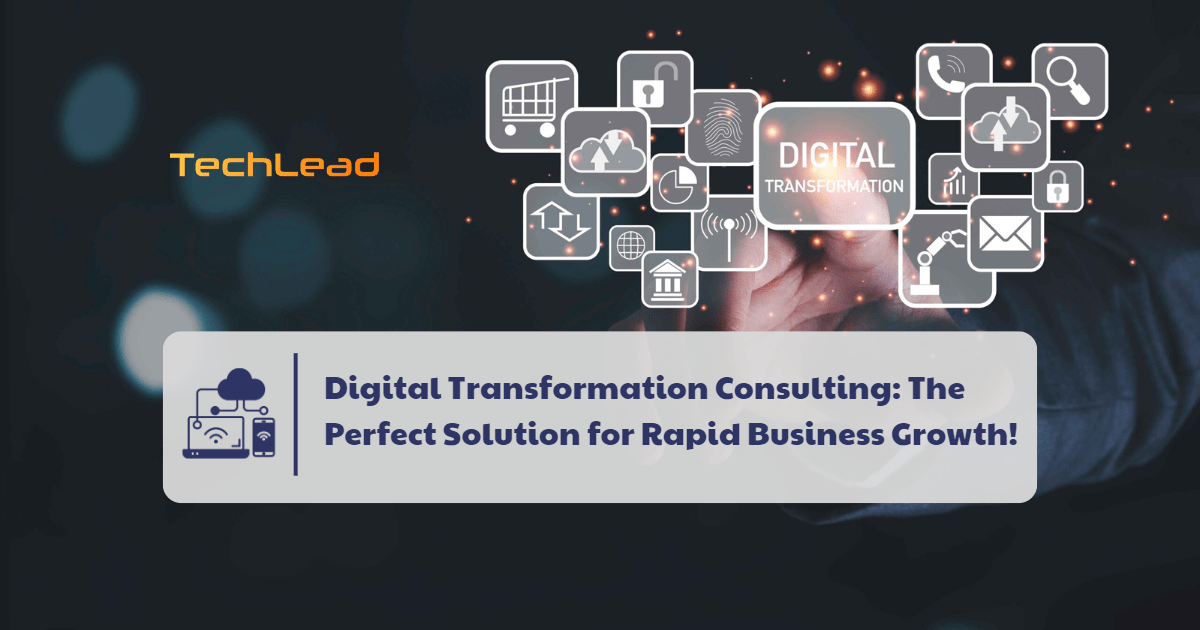
Digital Transformation Consulting: The Perfect Solution for Rapid Business Growth! (Collected)
Digital transformation refers to the comprehensive integration of digital technology into all areas of a business, fundamentally changing how organizations operate and deliver value to customers. In today’s fast-paced technological era, digital transformation is crucial as it enables businesses to enhance efficiency, innovate rapidly, and stay competitive in a digitally-driven market. The role of digital transformation consulting is pivotal in this context. Digital transformation consulting involves expert guidance to help organizations navigate the complexities of adopting new technologies, reengineering business processes, and fostering a culture of continuous improvement. Businesses require digital transformation consulting to ensure a strategic and structured approach to their transformation journey. With the rapid evolution of technology, many organizations struggle to keep up with the latest trends and innovations. Consulting experts offer valuable insights into emerging technologies and help companies to align their digital initiatives with their overall business objectives. By leveraging expert insights, businesses can mitigate risks, optimize resources, and achieve sustainable growth. Furthermore, consultants assist in building internal capabilities, ensuring that the organization can continue to evolve and adapt long after the initial transformation efforts are complete. In essence, digital transformation consulting acts as a catalyst, enabling businesses to unlock their full potential in the digital age.
Benefits of Digital Transformation for Businesses
In the contemporary business landscape, digital transformation has emerged as a critical driver of growth and competitiveness. By integrating digital technologies across all facets of operations, businesses can not only streamline their processes but also create new avenues for innovation and customer engagement. The benefits of digital transformation are multifaceted, encompassing enhanced operational efficiency, improved customer experiences, increased competitive advantage, and significant cost optimization. These advantages collectively empower businesses to navigate the complexities of the digital age and achieve rapid and sustainable growth.
1. Enhancing Operational Efficiency
Digital transformation significantly enhances operational efficiency by automating workflows and streamlining processes. Automation reduces the need for manual intervention, thereby minimizing errors and increasing productivity. By implementing advanced technologies such as robotic process automation (RPA) and artificial intelligence (AI), businesses can handle repetitive tasks more accurately and swiftly. This not only reduces operational costs but also allows employees to focus on more strategic activities, driving innovation and growth.
Moreover, digital tools enable better resource management by optimizing the use of available assets and reducing wastage. For example, predictive maintenance powered by IoT sensors can foresee equipment failures before they happen, thus preventing costly downtime and ensuring seamless operations. By eliminating inefficiencies and improving accuracy, digital transformation helps businesses achieve higher operational standards and deliver better value to their customers.
2. Improving Customer Experience

Improving Customer Experience (Collected)
One of the most significant benefits of digital transformation is the improvement of customer experience. Digital technologies enable businesses to provide fast and accurate customer service, enhancing overall satisfaction. For instance, chatbots and virtual assistants can offer instant support, resolving customer inquiries promptly. This immediate responsiveness builds customer trust and loyalty, which are crucial for long-term success.
Additionally, digital transformation allows for the personalization of services based on individual customer needs and preferences. Through the use of big data and analytics, companies can gather and analyze customer data to deliver tailored experiences. Personalized recommendations, targeted marketing, and customized solutions make customers feel valued and understood, thereby fostering deeper relationships and encouraging repeat business. By placing customers at the center of their strategy, businesses can create a competitive edge in the market.
3. Increasing Competitive Advantage
Digital transformation enhances a company’s competitive advantage by enabling it to tap into new markets and make data-driven decisions. With digital tools, businesses can expand their reach beyond geographical boundaries and explore untapped customer segments. E-commerce platforms, social media, and digital marketing strategies allow companies to engage with a global audience, increasing their market presence and revenue streams.
Data analytics plays a pivotal role in sharpening competitive edge. By collecting and analyzing vast amounts of data, businesses can gain valuable insights into market trends, customer behavior, and operational performance. This information empowers decision-makers to make informed choices, optimize strategies, and anticipate market changes. Data-driven decision-making ensures that businesses remain agile and proactive, adapting swiftly to evolving market dynamics and staying ahead of competitors.
4. Cost Optimization

Cost Optimization (Collected)
Digital transformation leads to significant cost optimization by reducing operational expenses and optimizing resource utilization. Automation and advanced analytics streamline processes, cutting down the need for manual labor and minimizing errors that lead to costly rework. Cloud computing and other digital solutions also enable businesses to scale their operations efficiently, reducing the need for substantial capital investments in physical infrastructure.
Furthermore, digital transformation allows for better resource allocation by providing real-time visibility into operations. Businesses can identify areas where resources are underutilized or misallocated, making necessary adjustments to enhance efficiency. By optimizing resources and eliminating waste, companies can lower their operational costs and improve their bottom line. This financial flexibility can be reinvested into growth initiatives, driving further development and innovation.
In conclusion, digital transformation stands as a cornerstone for modern business success. It enables companies to automate workflows, minimize errors, and optimize resource utilization, thereby significantly enhancing operational efficiency. Furthermore, by leveraging digital tools to deliver personalized and responsive customer experiences, businesses can foster stronger relationships and build customer loyalty. The ability to access and analyze data for informed decision-making provides a competitive edge, allowing companies to explore new markets and adapt swiftly to changing dynamics. Lastly, cost optimization through digital technologies ensures financial flexibility, enabling reinvestment in growth initiatives. Embracing digital transformation is not merely an option but a necessity for businesses aiming to thrive in an increasingly digital world.
Key Steps in the Digital Transformation Consulting Process
Digital transformation is a multifaceted process that fundamentally alters how businesses operate and deliver value to their customers through the adoption of digital technologies. As companies navigate this complex journey, digital transformation consulting plays a pivotal role in ensuring a structured and strategic approach. By following a series of key steps—assessing the current state of the business, defining goals and strategies, selecting appropriate technologies, implementing digital transformation, and continuously monitoring and optimizing—businesses can achieve rapid growth and maintain a competitive edge in today’s technology-driven market
1. Assessing the Current State of the Business
The first crucial step in the digital transformation consulting process is to thoroughly assess the current state of the business. This involves a comprehensive analysis of existing processes to identify inefficiencies and areas for improvement. Consultants will scrutinize the workflows, operational procedures, and business models currently in place. Additionally, an evaluation of the existing technology infrastructure is conducted to understand the capabilities and limitations of the systems being used. This includes assessing hardware, software, data management practices, and the overall IT environment. By gaining a clear understanding of the current state, consultants can identify gaps and opportunities for digital enhancement.
2. Defining Goals and Strategies
Defining Goals and Strategies (Collected)
Once the current state assessment is complete, the next step is to define clear, measurable goals and develop a strategic plan for digital transformation. Setting specific, achievable objectives is essential for guiding the transformation efforts and measuring progress. These goals should align with the overall business strategy and address the key areas identified during the initial assessment. The strategic plan will outline the roadmap for transformation, including timelines, milestones, and resource allocation. This plan serves as a blueprint for all subsequent activities, ensuring that the transformation efforts are coherent and focused on achieving the desired outcomes.
3. Selecting Appropriate Technologies
Choosing the right technology solutions is a critical aspect of digital transformation. Consultants will conduct a thorough analysis of various technological options, evaluating their feasibility, scalability, and potential impact on the business. This involves comparing different software, platforms, and tools to determine which ones best meet the specific needs and goals of the organization. Factors such as cost, ease of integration, and user adoption are also considered. By selecting the most suitable technologies, businesses can enhance their operational efficiency, improve customer experiences, and gain a competitive edge in the market.
4. Implementing Digital Transformation
The implementation phase is where the chosen technologies are deployed, and significant changes to business processes are made. This step involves the installation and configuration of new systems, migrating data, and integrating new tools with existing infrastructure. It is crucial to provide comprehensive training for employees to ensure they are proficient in using the new technologies and understand the revised workflows. Change management strategies are also employed to help staff adapt to new ways of working and to minimize resistance. Effective implementation requires careful planning and coordination to avoid disruptions and ensure a smooth transition.
5. Monitoring and Optimizing

The final step in the digital transformation consulting process is continuous monitoring and optimization. Once the new technologies and processes are in place, it is essential to regularly evaluate their performance and impact. Key performance indicators (KPIs) and metrics are used to measure the success of the transformation efforts. Based on these evaluations, strategies and processes may need to be adjusted to address any issues or to capitalize on new opportunities. Continuous improvement is a fundamental principle of digital transformation, ensuring that the business remains agile and can adapt to future technological advancements and market changes. This ongoing optimization helps businesses to sustain the benefits of digital transformation and drive long-term growth.
In conclusion, the process of digital transformation is essential for businesses aiming to thrive in the modern digital landscape. Through a detailed assessment of current processes and technology, the establishment of clear goals and strategies, the careful selection of appropriate technologies, and meticulous implementation and continuous optimization, companies can unlock their full potential. Digital transformation consulting provides the expertise and guidance necessary to navigate this journey successfully, ensuring that businesses not only keep pace with technological advancements but also drive significant growth and innovation. As the digital era continues to evolve, embracing digital transformation becomes not just an option, but a critical imperative for sustained success and competitiveness.
Challenges and Solutions in Implementing Digital Transformation
In the rapidly evolving landscape of modern business, digital transformation has emerged as a critical imperative for organizations seeking to stay competitive and relevant in an increasingly digital world. However, while the potential benefits of embracing digital technologies are vast, the journey towards digitalization is not without its challenges. Among the primary obstacles encountered by businesses undertaking digital transformation initiatives are human resistance, technological integration and security issues, and financial constraints.
1. Human Resistance
One of the primary challenges faced during digital transformation initiatives is the resistance to change from employees. Many individuals within the organization may be reluctant to adopt new technologies or processes, fearing job displacement or an increase in workload.
Internal Training and Communication To address this challenge, organizations need to prioritize internal training programs to equip employees with the necessary skills and knowledge to embrace digital changes effectively. Additionally, robust internal communication strategies should be implemented to foster understanding and buy-in among staff members regarding the benefits of digital transformation for both the organization and individual roles.
2. Technological Integration and Security Issues
Another significant challenge is posed by the complexities associated with integrating various technologies and ensuring the security of digital systems. As organizations adopt new software, platforms, and devices, they often encounter compatibility issues and vulnerabilities that can compromise data integrity and confidentiality.
Selection of Appropriate Technologies and Establishment of Secure Infrastructure To overcome this challenge, careful consideration should be given to selecting technologies that are compatible with existing systems and align with the organization’s specific needs and goals. Additionally, investing in robust cybersecurity measures and infrastructure is crucial to safeguarding sensitive data and mitigating the risks associated with digital threats. This includes implementing encryption protocols, access controls, and regular security audits to identify and address potential vulnerabilities proactively.
Technological Integration and Security Issues (Collected)
3. Financial Constraints

Financial Constraints (Collected)
A common obstacle faced by organizations embarking on digital transformation journeys is the high initial investment required to implement new technologies and processes. The upfront costs associated with purchasing software, hardware, and training can strain budgets, particularly for small and medium-sized enterprises (SMEs).
Seek Funding Sources and Calculate ROI To address financial constraints, organizations can explore various funding sources, such as grants, loans, or partnerships with technology vendors. Conducting a thorough cost-benefit analysis and calculating the Return on Investment (ROI) of digital transformation initiatives can also help justify expenditures and prioritize investments that yield the highest returns in terms of efficiency gains, cost savings, and revenue growth over time.
In conclusion, digital transformation represents a paradigm shift in the way organizations conduct business, offering transformative potential across all aspects of operations. However, realizing this potential requires addressing a range of challenges, including human resistance, technological complexities, and financial constraints. By proactively addressing these obstacles through strategies such as internal training and communication, careful technology selection, and financial planning, organizations can position themselves for success in the digital age. Ultimately, embracing digital transformation is not merely a matter of survival but a strategic imperative for driving innovation, efficiency, and long-term growth in today’s fast-paced business environment.
Case Studies: Successful Businesses Through Digital Transformation
In today’s rapidly evolving digital landscape, numerous businesses have successfully leveraged digital transformation to enhance their operations, expand their market reach, and achieve remarkable growth. Among these trailblazers are prominent companies such as Netflix, Adobe, Fujifilm, Nike, and Hasbro. Let’s delve into how each of these enterprises embraced digital transformation to achieve unprecedented success:
1. Netflix

Netflix (Collected)
Netflix, the streaming giant, revolutionized the entertainment industry by harnessing the power of data analytics. With millions of subscribers worldwide, Netflix possesses an extensive repository of user data, which it strategically utilizes to personalize the viewing experience. Through sophisticated algorithms analyzing viewer preferences, behaviors, and viewing patterns, Netflix delivers tailored content recommendations, thereby enhancing user engagement and retention rates. Moreover, Netflix’s data-driven approach extends beyond content recommendation to content creation. By leveraging insights gleaned from data analytics, Netflix produces original content tailored to diverse audience segments, ensuring that each production resonates with its target audience. This strategic use of data has propelled Netflix to become a content powerhouse, continuously attracting and retaining subscribers amidst fierce competition in the streaming industry.
2. Adobe

Adobe (Collected)
Adobe, renowned for its creative software suite, underwent a strategic digital transformation by transitioning to a cloud-based subscription model. This shift not only addressed challenges associated with software piracy but also revolutionized Adobe’s relationship with its customers. By offering subscription-based access to its software suite, Adobe provides customers with continuous updates and seamless access to the latest features and enhancements. Furthermore, Adobe’s integration of artificial intelligence (AI) and machine learning technologies into its products enhances user productivity and creativity. For instance, Adobe Sensei, its AI-powered platform, automates repetitive tasks, streamlines workflows, and facilitates intelligent content creation, empowering users to unleash their creative potential. This focus on innovation and customer-centricity has solidified Adobe’s position as a leader in the creative software industry, driving sustained growth and profitability.
3. Fujifilm

Fujifilm (Collected)
Fujifilm, a traditional player in the photography industry, successfully navigated the digital revolution by diversifying its product offerings and embracing digital innovation. Recognizing the declining demand for traditional film cameras, Fujifilm pivoted its focus towards digital cameras and invested in cutting-edge technologies such as mirrorless cameras and image processing software. This strategic shift enabled Fujifilm to capture a significant market share in the digital photography market and establish itself as a formidable competitor to industry leaders. Moreover, Fujifilm’s commitment to innovation extends beyond hardware to software solutions. By developing proprietary image processing algorithms and software applications, Fujifilm enhances the image quality and user experience of its digital cameras, catering to the evolving needs of photographers and enthusiasts. Additionally, Fujifilm’s emphasis on customer-centricity and user experience further fueled its growth in the digital era, fostering brand loyalty and differentiation in a competitive market landscape.
4. Nike

Nike (Collected)
Nike, the global sportswear giant, embraced digital transformation to reimagine the retail experience and strengthen its connection with consumers. Leveraging digital technologies, Nike seamlessly integrates online and offline channels to provide consumers with a cohesive and personalized shopping experience. Through innovative initiatives such as the Nike+ app and NikeID customization platform, Nike empowers consumers to engage with its brand across multiple touchpoints, from browsing products online to customizing and purchasing them in-store. Moreover, Nike’s data-driven approach to product design and marketing enables the company to anticipate consumer trends, personalize offerings, and optimize marketing campaigns for maximum impact. By leveraging digital integration to enhance the retail experience and deepen consumer engagement, Nike has successfully differentiated itself in a competitive market landscape, driving brand loyalty and revenue growth.
5. Hasbro

Hasbro (Collected)
Hasbro, a leading toy and entertainment company, embraced digital transformation to stay relevant in an increasingly digitized world. By leveraging digital platforms and partnerships, Hasbro expanded its reach beyond traditional retail channels and tapped into new markets, including online marketplaces and streaming platforms. Additionally, Hasbro’s integration of augmented reality (AR) and virtual reality (VR) technologies into its products enhances the overall play experience, captivating tech-savvy consumers and driving sales growth. For instance, Hasbro’s collaboration with gaming companies to develop digital versions of its iconic board games enables consumers to enjoy classic gameplay experiences in a digital format, appealing to a new generation of players. Furthermore, Hasbro’s investment in digital content creation and distribution allows the company to engage with consumers beyond the physical toy space, creating immersive entertainment experiences that resonate with today’s digitally savvy audiences. By digitally enabling play and entertainment, Hasbro continues to innovate and evolve its business model, driving sustained growth and relevance in a rapidly changing market landscape.
In conclusion, the success stories of Netflix, Adobe, Fujifilm, Nike, and Hasbro underscore the transformative power of digital innovation. By embracing digital transformation, these companies have not only thrived in today’s competitive landscape but also set new benchmarks for industry excellence. Their journeys serve as inspirational examples for businesses seeking to embark on their own digital transformation endeavors, highlighting the importance of innovation, customer-centricity, and strategic adaptation in driving sustainable growth and success.
Conclusion
In conclusion, digital transformation consulting offers the perfect solution for businesses seeking rapid growth and sustainable success in today’s digital-first world. By partnering with experienced consultants, businesses can unlock their full potential, drive innovation, and future-proof their operations for long-term success. Embrace digital transformation today and embark on a journey towards greater growth and prosperity.
TECHLEAD – Leading technology solution for you!
Hotline: 0372278262
Website: https://www.techlead.vn
Linkedin: https://www.linkedin.com/company/techlead-vn/
Email: [email protected]
Address: 4th Floor, No. 11, Nguyen Xien, Thanh Xuan, Hanoi








